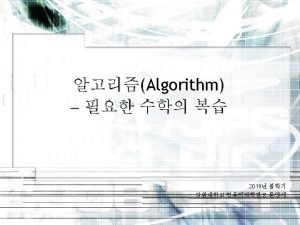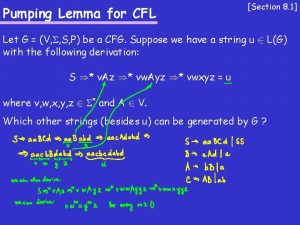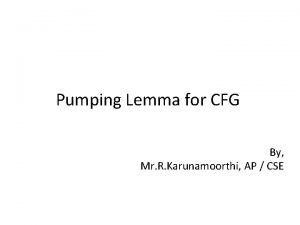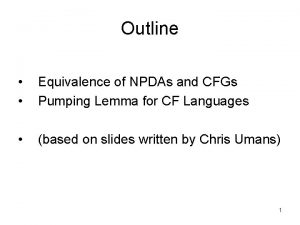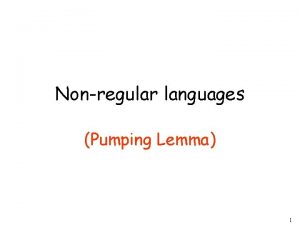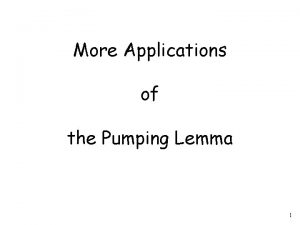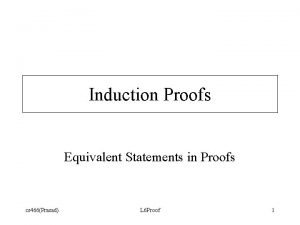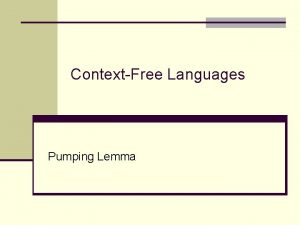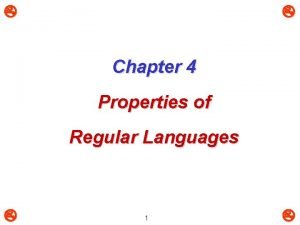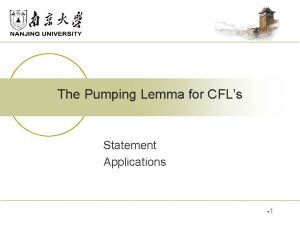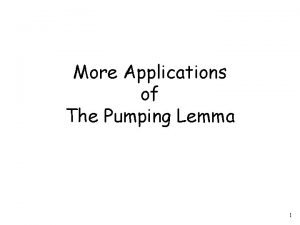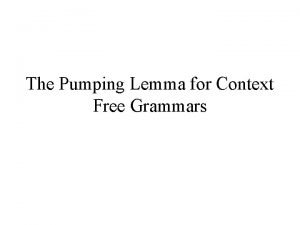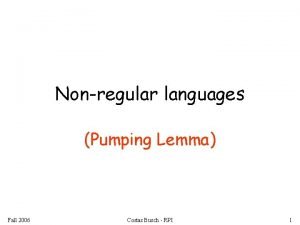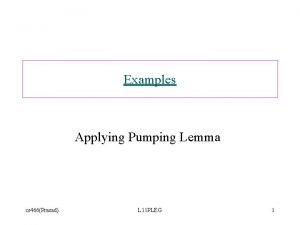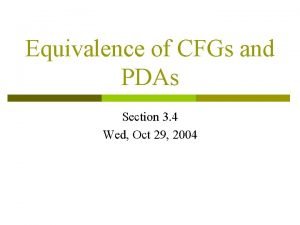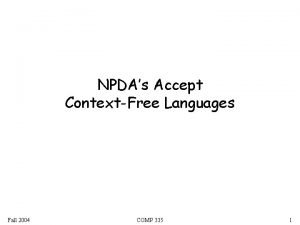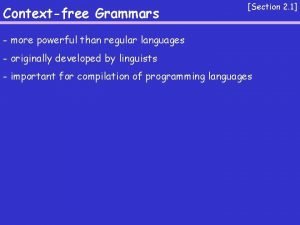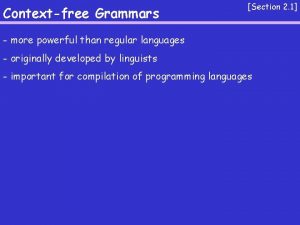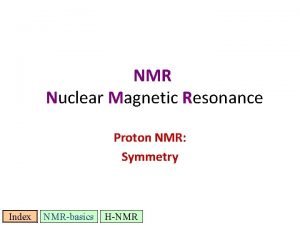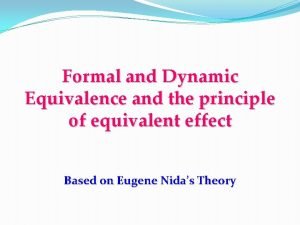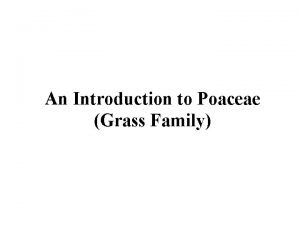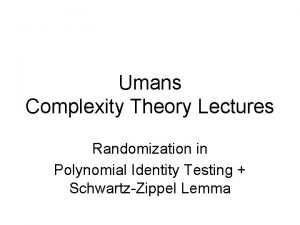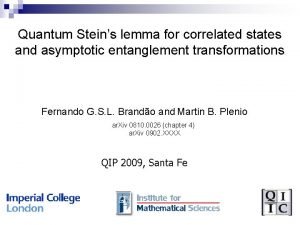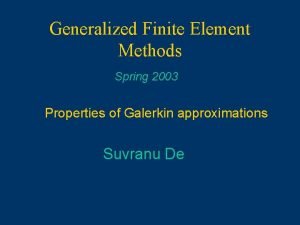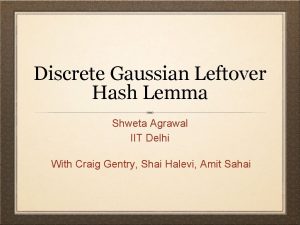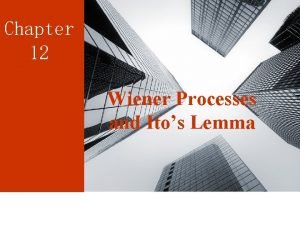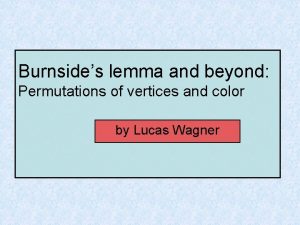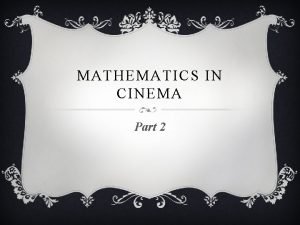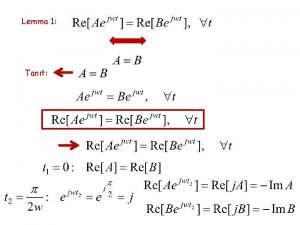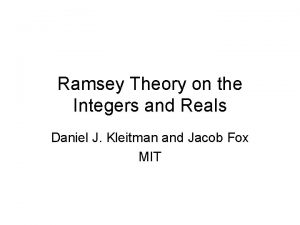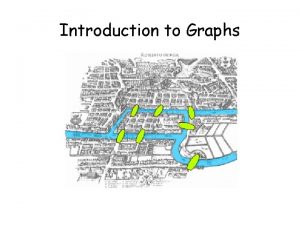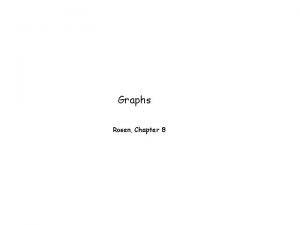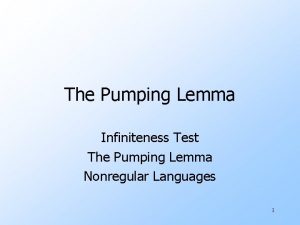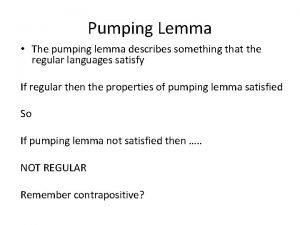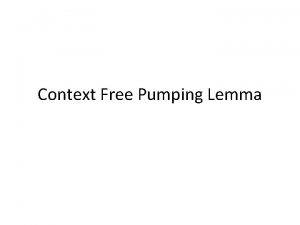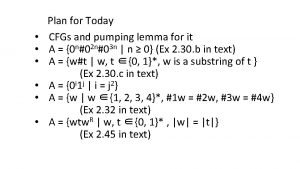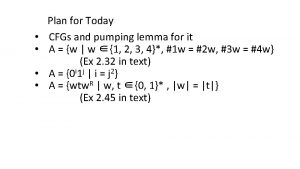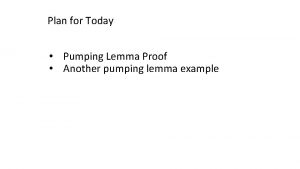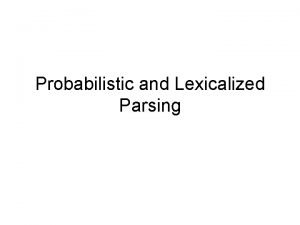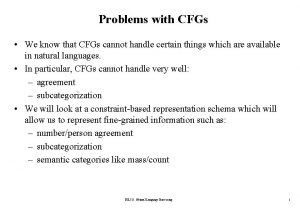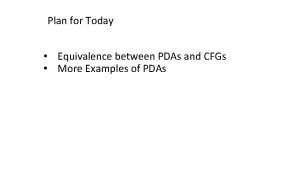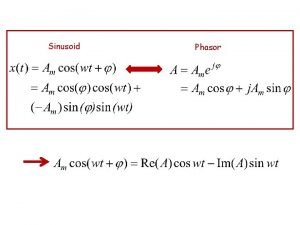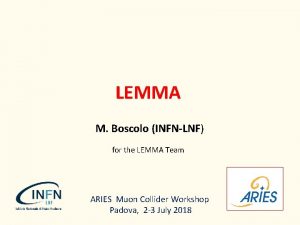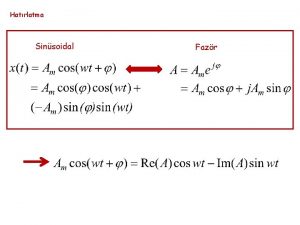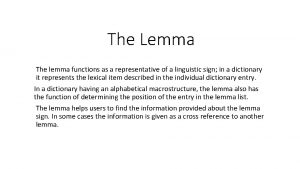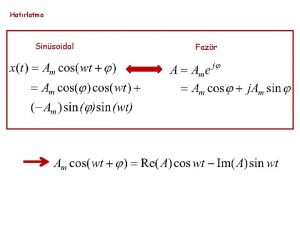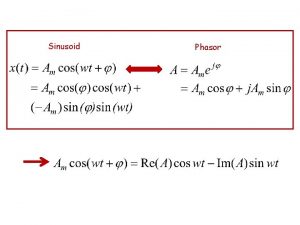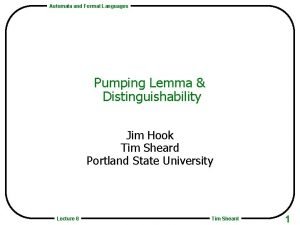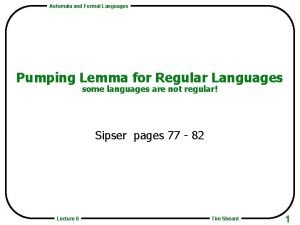Outline Equivalence of NPDAs and CFGs Pumping Lemma







































- Slides: 39

Outline • • Equivalence of NPDAs and CFGs Pumping Lemma for CF Languages • (based on slides written by Chris Umans) 1

Context-Free Grammars start symbol A → 0 A 1 A → B B → # terminal symbols non-terminal symbols production 2

Example of CFG <expr> → <expr> + <term> | <term> → <term> * <factor> | <factor> → <term> * <factor> → (<expr>) | a 3

Parse Trees • parse tree for a + a * a in the grammar: <expr> → <expr> + <term> | <term> → <term> * <factor> | <factor> → <term> * <factor> → (<expr>) | a <expr> + <term> <factor> a <term> <factor> * <factor> a a 4

Some facts about CFLs • CFLs are closed under – union – concatenation – star (proof? ) • Every regular language is a CFL – proof? 5

NPDA, CFG equivalence • 6

NPDA, CFG equivalence • 0 # 1 an idea: A → 0 A 1 A → # q 1 0 # 1 q 2 0 # 1 q 3 0 0 0 A # # 1 1 1 $ $ $ : : : 7

NPDA, CFG equivalence 1. we’d like to non-deterministically guess the derivation, forming it on the stack 2. then scan the input, popping matching symbol off the stack at each step 3. accept if we get to the bottom of the stack at the end of the input. what is wrong with this approach? 8

NPDA, CFG equivalence – only have access to top of stack – combine steps 1 and 2: • allow to match stack terminals with tape during the process of producing the derivation on the stack 0 # 1 q 1 A → 0 A 1 A → # 0 # 1 q 2 0 # 1 q 3 0 A # A 1 1 1 $ $ $ 9

NPDA, CFG equivalence • informal description of construction: – place $ and start symbol S on the stack – repeat: • if the top of the stack is a non-terminal A, pick a production with A on the lhs and substitute the rhs for A on the stack • if the top of the stack is a terminal b, read b from the tape, and pop b from the stack. • if the top of the stack is $, enter the accept state. 10

NPDA, CFG equivalence ε, ε → S$ one transition for each production A → w q ε, A → w b, b → ε ε, $ → ε ε, A → w = w 1 w 2…wk r shorthand for: ε, ε → wk-1 one transition for q 2 … ε, A → wk each terminal b q 1 q ε, ε → w 1 qk r 11

NPDA, CFG equivalence • 12

NPDA, CFG equivalence – main idea: non-terminal Ap, q generates exactly the strings that take the NPDA from state p (w/ empty stack) to state q (w/ empty stack) – then Astart, accept generates all of the strings in the language recognized by the NPDA. 13

NPDA, CFG equivalence • Two possibilities to get from state p to q: generated by Ap, r generated by Ar, q stack height p input r q abcabbacacbacbacabbabbabaacabbbababaacaccaccccc string taking NPDA from p to q 14

NPDA, CFG equivalence • 15

NPDA, CFG equivalence • Two possibilities to get from state p to q: stack height generated by Ar, s r p push d input s pop d q abcabbacacbacbacabbabbabaacabbbababaacaccaccccc string taking NPDA from p to q 16

NPDA, CFG equivalence • from state p, read a, push d, move to state r from state s, read b, pop d, move to state q 17

NPDA, CFG equivalence • 18

NPDA, CFG equivalence • two claims to verify correctness: 1. if Ap, q generates string x, then x can take NPDA P from state p (w/ empty stack) to q (w/ empty stack) 2. if x can take NPDA P from state p (w/ empty stack) to q (w/ empty stack), then Ap, q generates string x 19

NPDA, CFG equivalence 1. if Ap, q generates string x, then x can take NPDA P from state p (w/ empty stack) to q (w/ empty stack) – induction on length of derivation of x. – base case: 1 step derivation. must have only terminals on rhs. In G, must be production of form Ap, p → ε. 20

NPDA, CFG equivalence 1. if Ap, q generates string x, then x can take NPDA P from state p (w/ empty stack) to q (w/ empty stack) – assume true for derivations of length at most k, prove for length k+1. – verify case: Ap, q → Ap, r. Ar, q →k x = yz – verify case: Ap, q → a. Ar, sb →k x = ayb 21

NPDA, CFG equivalence 2. if x can take NPDA P from state p (w/ empty stack) to q (w/ empty stack), then Ap, q generates string x – induction on # of steps in P’s computation – base case: 0 steps. starts and ends at same state p. only has time to read empty string ε. – G contains Ap, p → ε. 22

NPDA, CFG equivalence 2. if x can take NPDA P from state p (w/ empty stack) to q (w/ empty stack), then Ap, q generates string x – induction step. assume true for computations of length at most k, prove for length k+1. – if stack becomes empty sometime in the middle of the computation (at state r) • y is read going from state p to r • z is read going from state r to q • conclude: Ap, q → Ap, r. Ar, q →* yz = x (Ap, r→* y) (Ar, q→* z) 23

NPDA, CFG equivalence 2. if x can take NPDA P from state p (w/ empty stack) to q (w/ empty stack), then Ap, q generates string x – if stack becomes empty only at beginning and end of computation. • • first step: state p to r, read a, push d go from state r to s, read string y last step: state s to q, read b, pop d conclude: Ap, q → a. Ar, sb →* ayb = x (Ar, s→* y) 24

NPDA, CFG equivalence 2. if x can take NPDA P from state p (w/ empty stack) to q (w/ empty stack), then Ap, q generates string x – if stack becomes empty only at beginning and end of computation. • • first step: state p to r, read a, push d go from state r to s, read string y last step: state s to q, read b, pop d conclude: Ap, q → a. Ar, sb →* ayb = x (Ar, s→* y) 25

Pumping Lemma for CFLs • 26

CFL Pumping Lemma Example • 27

CFL Pumping Lemma Example – possibilities: w = aaaa…aaabbb…bbcccc…c u v x y z (if v, y each contain only one type of symbol, then pumping on them produces a string not in the language) 28

CFL Pumping Lemma Example – possibilities: w = aaaa…abbbb…bccccc…c u v x y z (if v or y contain more than one type of symbol, then pumping on them might produce a string with equal numbers of a’s, b’s, and c’s – if vy contains equal numbers of a’s, b’s, and c’s. But they will be out of order. ) 29

CFL are not closed under intersection and complementation • 30

CFL Pumping Lemma Example • 31

Closure properties of Context Free Languages • 32

CFL Pumping Lemma: Another Example • 33

CFL Pumping Lemma • long path S A A a . . . S C S D A C b A . . . B A . . . B A D a b b S S b b some non-terminal must repeat on long path a a C D C B A b b a 34

CFL Pumping Lemma S • Schematic proof: S A A u v x S u v A y z A u v A y z v x y 35

CFL Pumping Lemma S • Schematic proof: S A A u v x u A z y z x u z 36

CFL Pumping Lemma – how large should pumping length p be? – need to ensure other conditions: |vy| > 0 |vxy| ≤ p – b = max # symbols on rhs of any production (assume b ≥ 2) – if parse tree has height ≤ h, then string generated has length ≤ bh (so length > bh implies height > h) 37

CFL Pumping Lemma – let m be the # of nonterminals in the grammar – to ensure path of length at least m+2, require |w| ≥ p = bm+2 – since |w| > bm+1, any parse tree for w has height > m+1 – let T be the smallest parse tree for w – longest root-leaf path must consist of ≥ m+1 non-terminals and 1 terminal. 38

CFL Pumping Lemma S • A A u v x y z – is |vy| > 0 ? • smallest parse tree T ensures – is |vxy| ≤ p? • red path has length ≤ m+2, so ≤ bm+2 = p leaves 39
 Applications of pumping lemma
Applications of pumping lemma Pumping lemma proof
Pumping lemma proof Pumping lemma for cfl examples
Pumping lemma for cfl examples Pumping lemma of cfg
Pumping lemma of cfg Pumping lemma 예제
Pumping lemma 예제 Pumping lemma non regular languages examples
Pumping lemma non regular languages examples Pumping lemma
Pumping lemma Pumping lemma meme
Pumping lemma meme Pumping lemma for cfls
Pumping lemma for cfls Pumping lemma 예제
Pumping lemma 예제 Pumping lemma for cfls
Pumping lemma for cfls Pumping lemma generator
Pumping lemma generator Pumping lemma for context-free languages examples
Pumping lemma for context-free languages examples Pumping lemma pigeonhole principle
Pumping lemma pigeonhole principle Pumping lemma for regular languages
Pumping lemma for regular languages Pdas and cfgs are equivalent
Pdas and cfgs are equivalent Npdas
Npdas Cfgs are more powerful than:
Cfgs are more powerful than: Cfgs are more powerful than:
Cfgs are more powerful than: Homotopic protons
Homotopic protons Dynamic equivalent
Dynamic equivalent Formal equivalent
Formal equivalent Example of a sentence outline
Example of a sentence outline Grass flower diagram
Grass flower diagram Lemma and palea
Lemma and palea Schwartz-zippel lemma and polynomial identity testing
Schwartz-zippel lemma and polynomial identity testing Ito's lemma black scholes
Ito's lemma black scholes Locc
Locc Lemma consulting
Lemma consulting Ceas lemma
Ceas lemma Leftover hash lemma
Leftover hash lemma Ito s lemma
Ito s lemma Almost essential
Almost essential Burnsides lemma
Burnsides lemma Snake lemma scene
Snake lemma scene Lemma 2
Lemma 2 Ramsey theory
Ramsey theory Patrizia lemma
Patrizia lemma Königsberg
Königsberg Handshaking theorem
Handshaking theorem

